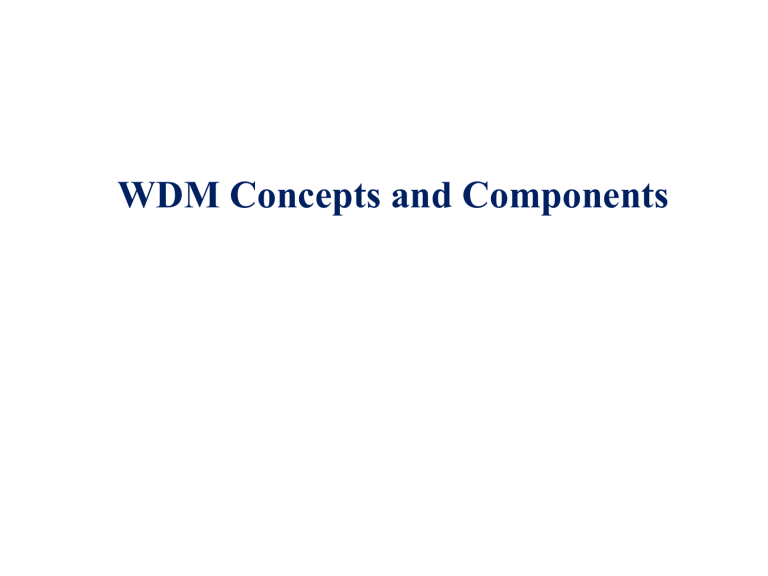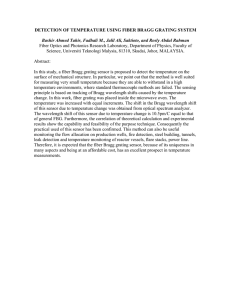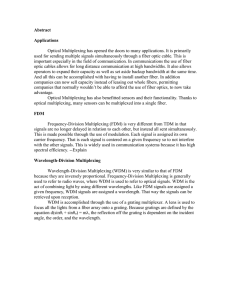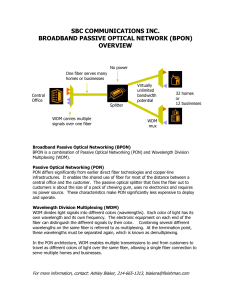
WDM Concepts and Components • Wavelength division multiplexing is a kind of frequency division multiplexing • A technique where optical signals with different wavelengths are combined, transmitted together, and separated again. • It is mostly used for optical fiber communications to transmit data in several (or even many) channels with slightly different wavelengths. • The transmission capacities of fiber-optic links can be increased strongly, so that most efficient use is made not only of the fibers themselves but also of the active components such as fiber amplifiers. • At the transmitter side, multiple optical transmitters – each emitting at a different wavelength – individually send signals and these signals are multiplexed by a wavelength multiplexer (MUX). • The multiplexed signals are then transmitted over one main transmission line (optical fiber cable). At the receiver side, the signals are de-multiplexed by a wavelength de-multiplexer (DEMUX) and sent to multiple receivers. 2 3 • A characteristic of WDM is that the discrete wavelengths form an orthogonal set of carriers that can be separated, routed, and switched without interfering with each other. • WDM networks require a variety of passive and active devices to combine, distribute, isolate, and amplify optical power at different wavelengths. 4 WDM Spectral Bands • Many independent narrowband regions in the O- through Lbands can be used simultaneously. • These regions are designated either in terms of spectral width or optical bandwidth. • The optical bandwidth Δν related to a particular spectral width Δλ is found by differentiating c = λν; for Δλ << λ2 5 •Coarse WDM (CWDM): • CWDM is defined by WDM systems with fewer than eight active wavelengths per fiber. • CWDM is used for short-range communications, so it employs wide-range frequencies with wavelengths that are spread far apart. • Standardized channel spacing permits room for wavelength drift as lasers heat up and cool down during operation. • CWDM is a compact and cost-effective option when spectral efficiency is not an important requirement. Dense WDM (DWDM): • DWDM is defined in terms of frequencies. • DWDM’s tighter wavelength spacing fits more channels onto a single fiber, but costs more to implement and operate. • DWDM is for systems with more than eight active wavelengths per fiber. DWDM dices spectrum finely, fitting 40-plus channels into the C-band frequency range. 6 WDM Standards • Developed by ITU • Here a fixed frequency spacing • ITU-T Recommendation G.694.1 specifies DWDM operation in the S-, C-, and L-bands for frequency spacing of 100 to 12.5 GHz (or, equivalently, 0.8 to 0.1 nm at 1550 nm). • ITU.T.G.692 to G.694.1 for metro area network and wide area network for frequency 100 to 12.5 GHz(high quality LED) • The number NM is used by ITU-T to designate a specific 19N.M-THz Cband 100-GHz channel, e.g., the frequency 194.3 THz is ITU channel 43. 7 ADVANTAGE WDM technology is in reducing the number of fibers used in the main transmission line. The distance of an optical transmission line sometimes exceeds 1,000 km, and the cost of fiber cable manufacturing/deployment would become a serious issue if we need to install a high-fibercount cable over a very long distance. The number of wavelength multiplexer/de-multiplexer basically remains the same no matter how long the transmission distance is. One of the most widely used technology for high-capacity optical communication systems. 8 Passive Optical Couplers • Passive devices operate completely in the optical domain to split and combine light streams. • They include N N couplers (with N ≥ 2), power splitters, power taps, and star couplers. • They can be fabricated either from optical fibers or by means of planar optical waveguides using material such as LiNbO3, InP, silica, silicon oxynitride, or various polymers. 9 The 2 2 Fiber Coupler • • P0 is the input power, P1 is the throughout power, and P2 is the power coupled into the second fiber. P3 and P4 are extremely low signal levels (-50 to -70 dB below the input level) resulting from backward reflections and scattering in the device Optical power coupling 10 Performance of an Optical Coupler • 3-dB coupler: P1 = P2 = 0.5 P0 • Tap coupler: P2 = 0.005 P0 (- 23 dB) 11 Star Couplers • In general, an N M coupler has N inputs and M outputs 12 Optical Circulators • An optical circulator is a nonreciprocal multiport passive device that directs light sequentially from port to port in only one direction. • In the 3–port example, an input on port 1 is sent out on port 2, an input on port 2 is sent out on port 3, and an input on port 3 is sent out on port 1. 13 Fiber Bragg Grating (FBG) • A Filter that separates Light into many wavelength via Bragg’s law. Generally refers to a Fiber Bragg grating used in optical communications to separate and combining wavelengths. • A fiber Bragg grating (FBG) is a type of distributed Bragg reflector constructed in a short segment of optical fiber that reflects particular wavelengths of light and transmits all others. 14 • This is achieved by creating a periodic variation in the refractive index of the fiber core, which generates a wavelength-specific dielectric mirror. • A fiber Bragg grating can therefore be used as an inline optical filter to block certain wavelengths, or as a wavelength-specific reflector. 15 • The refractive index of the fiber core is modulated with a period of Λ. • When a light with a broad spectrum is launched into one end of fiber containing a fiber Bragg grating, the part of the light with wavelength matching the Bragg grating wavelength will be reflected back to the input end, with the rest of the light passing through to the other end. 16 From the momentum conservation requirement of the Bragg grating condition, the following equation can be obtained: Therefore, the Bragg grating wavelength λB can be expressed as 17 Example formation: Two ultraviolet beams will create a permanent interference pattern in a GeO2-doped silica fiber to form a periodic index variation along the axis.(photo imprinting method) Exposure to the high intensity UV radiation, the refractive index of the fiber core (n) permanently changes to a periodic function of z z: Distance measured along fiber core axis : Pitch of the grating ncore: Core refractive index 18 Fiber Bragg Grating Application Demultiplexing (wavelength dropping) process: • Consider 4 wavelengths entering a circulator at port 1. • All wavelengths exit from port 2. • The fiber Bragg grating is designed to reflect λ2 and pass all other wavelengths. • After reflection, λ2 enters port 2 and comes out of port 3. 19 Multiplexing of Four Wavelengths • One needs to cascade N-1 FBGs and N-1 circulators for combining or separating N wavelengths. • Example for multiplexing four wavelengths using three FBGs and three circulators (labeled C2, C3, and C4). The fiber grating filters labeled • FBG2, FBG3, and FBG4 are constructed to reflect wavelengths λ2, λ3, and λ4, respectively, and to pass all others. 20 Advantages • Easy to manufacture, low cost, ease of coupling • Minimal insertion losses – approx. 0.1 db or less • Passive devices Disadvantages • Sensitive to temperature and strain. • Any change in temperature or strain in a FBG causes the grating period and/or the effective refractive index to change, which causes the Bragg wavelength to change. 21 Etalon Theory • A dielectric thin-film filter (TFF) is used as an optical bandpass flter. • It allows a very narrow wavelength band to pass straight through it and reflects all other wavelengths. • The basis of these devices is a reflective mirror surfaces called a FabryPerot interferometer or an etalon. • The transmission T of an ideal etalon in which there is no light absorption by the mirrors is an Airy function • The periodicity of the device is called the free spectral range or FSR 22 Dielectric reflector stacks Throughput k Input: 1 … N Reflection: 1 … k-1 , k+1 … N Dielectric cavity layers Glass substrate Filter transmission (dB) Dielectric Thin-Film Filter 0 -10 3 cavities Steep rolloff 2 cavities -20 1 cavity -30 -40 0.996 0.998 1 1.002 1.004 Relative wavelength c/ A thin-film dielectric resonant cavity filter is a Fabry-Perot interferometer Mirrors surrounding cavity are multiple reflective dielectric thin-film layers Cavity length determines a particular wavelength to pass & reflects all others Flat passbands with steep rolloffs Low insertion loss: 0.5 dB at peak and < 3.5 dB at center frequency ± 10 GHz High optical return loss (> 45 dB) Thin-film filters with a 50-GHz passband are commercially available 23 Arrayed Waveguide Grating 4 3 Lens region 2 1, 2, 3, 4 1 Lens region 5 2 3 1 6 At (4): DF = 2p neff DL / c neff = effective index c = center wavelength At (6): DFSR = c2/ (DL neff) FSR-A FSR-B 1A ·· 4A 1B ·· 4B 4 4 The input waveguides (1) enter a lens region (2) (2) divides the power among the different waveguides in the grating array (3) Each grating waveguide has a precise length difference DL with its neighbors Light in each waveguide emerges with different phase delays DF at (4) The second lens region (5) refocuses the light from all array waveguides onto the output waveguide array (6) [DFSR = free spectral range = AWG periodicity] Each wavelength is focused into a different output waveguide in region (6) 24 FSR Example • The FSR specifies the spectral width that will be separated across the output waveguides of an AWG 25 Diffraction-Grating Couplers • Diffraction gratings spatially separate s in a beam • Reflection gratings are ruled or etched fine parallel lines on a reflective surface • Transmission gratings have periodic index variations • Each wavelength will reflect or refract at a different angle 26 Active Optical Components • Active components require some type of external energy either to perform their functions or to be used over a wider operating range than a passive device, thereby offering greater application flexibility • Many active optical components use micro-electrical-mechanical systems or MEMS technology • A simple example of a MEMS actuation method. 27 Examples of Active Devices A tunable optical filter can be varied to select a specific narrow spectral band within a much wider optical band. A dynamic gain equalizer (DGE) equalizes the gain profile of an erbium-doped fiber amplifier (EDFA) An optical add/drop multiplexer (OADM) inserts (adds) or extracts (drops) wavelengths at a designated point in an optical network. 28 Optical Isolators Optical isolators allow light to pass in only one direction. • This prevents scattered or reflected light from traveling in the reverse direction. • E.g., can keep backward-traveling light from entering a laser diode and possibly causing instabilities in the optical output. Polarizationindependent isolator made of three miniature optical components 29 Isolator and Circulator Parameters 30




